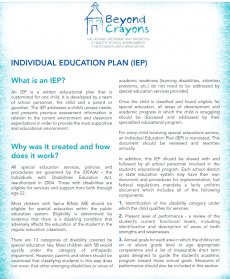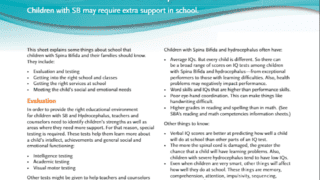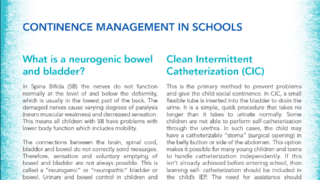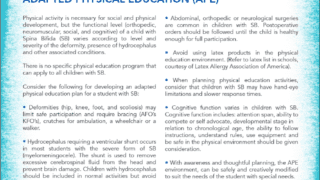An IEP is a written educational plan that is customized for one child.
It is developed by a team of school personnel, the child and a parent or guardian. The IEP addresses a child’s unique needs and presents previous assessment information about the current environment and classroom expectations to provide the most supportive and educational environment.
Why was it created and how does it work?
All special education services, policies, and procedures are governed by the IDEA(A) – the Individuals with Disabilities Education Act, reauthorized in 2004. Those with disabilities are eligible for services and support from birth through age 22. Most children with Spina Bifida (SB) should be eligible for special education within the public education system. Eligibility is determined by evidence that there is a disabling condition that adversely affects the education of the student in the regular education classroom.
There are 13 categories of disability covered by special education law. Most children with SB would qualify under the category of orthopedic impairment. However, parents and others should be cautioned that classifying students in this way does not mean that other emerging disabilities or areas of academic need (learning disabilities, attention problems, etc.) do not need to be addressed by special education services provided. Once the child is classified and found eligible for special education, all areas of development and academic progress in which the child is struggling should be discussed and addressed by their specialized educational program.
For every child receiving special educations service, an Individual Education Plan (IEP) is mandated. This document should be reviewed and rewritten annually. Also, this IEP should be shared with and followed by all school personnel involved in the student’s educational program. Each school district or state education system may have their own document and procedures for implementation, but federal regulations mandate a fairly uniform document which includes all of the following components:
1.Identification of the disability category under which the child qualifies for services.
2. Present level of performance – a review of the student’s current functional levels, including identification and description of areas of both strengths and weaknesses.
3. Annual goals for each area in which the child is not on or above grade level or age appropriate competence and a list of measurable short-term goals designed to guide the student’s academic program toward those annual goals. Measures of performance should also be included in this section (specific descriptions of how and when the assessment will be done to monitor progress toward short-term objectives and annual goals.
4. Educational placement – where the services will be delivered. One of the principle guarantees under the law is the least restrictive environment (LRE). This guarantees that special education services will be provided in a setting that mirrors general classroom education with non-disabled peers as closely as possible without sacrificing adequate educational services. The placement decision is one of the most critical ones for students and their parents or guardians. There are many pros and cons to both general classroom placement and alternative placements such as inclusion classrooms, resource room instruction, self-contained special education classroom, or even specialized schools.
5. Identification of any related services that will be provided to the student, such as speech therapy, physical therapy, counseling, etc. Federal law mandates that any of these services determined to be appropriate be provided at no cost to families.
6. Identification of any auxiliary aides necessary to facilitate learning, such as classroom computers or other technology tools, listening or speaking devices, or personal aides. These auxiliary aides must also be provided at no cost to families.
7. Accommodations are adjustments made to “level the playing field” during educational assessment or testing. These may include additional time to complete assignments or tests, scribes for tests, or use of computers/calculators during assessments. Accommodations are particularly important in light of recent trends in many states toward high stakes standardized testing for accountability purposes. Students with disabilities and students receiving special education services are often inherently disadvantaged by these kinds of assessments. Parents (and students) should be aware of the following: whether or not their child will be required to participate in district-wide standardized tests, what impact these tests may have on their child’s academic program, and what specific accommodations will be implemented in order to lessen the impact of the disability on test performance.
8. An Individual Transition Plan (ITP) is for all students 14 and older. This plan should establish annual goals related to post-secondary planning, such as: transportation, post-secondary education, independent living, and employment. Parents and students should actively participate in the IEP process on an annual basis. They should attend IEP meetings whenever they are scheduled and come to the meetings prepared to ask important questions about placement, assessments and proposed annual goals.
Special Education Guarantee
1. Notification & Consent Schools must notify parents or guardians of any planned discussions about classification (the labeling of a student’s disability to make them eligible for special education), IEP development or any changes in the student’s placement or program. Lack of response to meeting invitations on the parent’s part can be interpreted as implicit agreement with the committee’s decisions.
2. Procedural Safeguards All students eligible for special education services and their parents or guardians are entitled to due process with regard to the airing of grievances. Current law provides for mediation, impartial hearings and the right to seek representation by an advocate or lawyer. For more detailed information regarding procedural safeguards and legal rights under IDEA, please see go to: idea.ed.gov.
3. Academic Progress/Educational Benefit -IDEA guarantees that services provided will produce demonstrable benefit and academic achievement. One of the reasons that IEP’s must be reviewed and updated annually is so all parties can ensure that services are effective and IEP goals are resulting in adequate progress. Practices that are not resulting in positive outcomes can and should be altered.
The IEP Committee
The team of individuals involved in the writing and review of the IEP should consist of:
- At least one special education teacher(preferably one directly involved in the student’s services)
- At least one of the student’s general education teachers
- A representative of the school, such as an assistant principal, guidance counselor or other school administrator
- A professional who can interpret any assessment data, such as a school psychologist
- A parent or guardian
- The student, if appropriate
The IEP committee may also include related service personnel with knowledge of the student’s needs, such as: adaptive physical education teacher, speech therapist, guidance counselor, etc.
This information does not constitute medical advice for any individual. As specific cases may vary from the general information presented here, SBA advises readers to consult a qualified medical or other professional on an individual basis.
Tags



